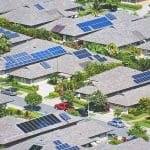Every year more Arizona home and business owners switch to solar power. In fact in 2018, Arizona ranked as number two in the United States for net generation of solar energy with only California producing more.
It makes sense as new developments and improvements to solar cell technology make the cost of an installation less expensive by the day. In only ten years, the cost of installation has fallen 65% from $8.50 per watt to less than $3 per watt.
Generally speaking, dollar per watt is how you will see solar installers communicate the system price but what exactly does that number include? Below we discuss the components needed to install a solar system and why.
COMPONENTS OF A SOLAR PANEL SYSTEM
SOLAR PANELS
There are a few different types of solar panels available for a small-scale solar system, such as a roof-top installation. There are monocrystalline panels, polycrystalline panels and thin-film panels. The most common panel type you will see is monocrystalline.
The reason for this is that the monocrystalline panels are the most efficient, meaning you need less panels to produce the same if not more electricity than you would for the other two types.
The difference in efficiency originates in how the solar cell used in each panel is created. Monocrystalline cells are formed from a single silicon crystal, while polycrystalline cells are formed from the combination of multiple silicon crystals, hence the names.
If you would like to dive deeper into panel types and how they work, check out our article Types of Solar Panels.
Typically though, the only panel type you will see offered by installers is monocrystalline as it has the highest efficiency rating and is commonly preferred for its aesthetics, as well.
SOLAR RACKING SYSTEM
Usually, solar panels are not installed directly onto a roof. Instead they are mounted to a rack, which is then connected to the roof. This method provides a number of advantages to the solar system.
For one, this allows us to control the tilt of the panels, which affects the amount of direct sunlight they receive. Basically, the further you are from the equator the lower the sun reaches in the sky and vice versa.
In Alaska, for example, solar panels need a fairly large angle of tilt to face directly at the sun. Thankfully, Arizona is so far south that the sun reaches quite high in the sky, giving us more hours of sunshine and more direct sunlight than almost all other states.
Another advantage of a racking system is that it keeps the panels cooler. Surprisingly, the cooler your panels, the more efficiently they will be. The racking system keeps the panels lifted, allowing more air to flow around them, thus cooling the system.
SOLAR INVERTER
The solar inverter is a vital part of a solar panel installation because it changes the electricity produced from your panels into electricity that can be used by your home.
You see, a solar system creates electricity in the form of a Direct Current (DC) while homes are outfitted to use electricity in the form of Alternating Current (AC). So an inverter is used to switch the DC power of your solar system into AC power which your home can use.
The inverter you need is based on whether you choose an on-grid or off-grid system. For an off-grid system, one that is not connected to the city’s electric grid, the inverter will be changing your DC electricity into AC to be stored in your battery storage system.
For an on-grid system, the inverter will act as the link between your house and the city’s electric grid. It will send any extra energy produced by your system that is not needed by your home to the city’s grid, which in many cases you can be paid for through net metering.
In the event of a power outage, the inverter also keeps any electricity produced from your system from entering the city’s grid. This protects any technicians working on power lines from being zapped.
SOLAR STORAGE
Frequently with a solar system, you will produce more energy than your home needs. When this happens, you will need a place for the extra electricity to go.
For an on-grid system, you can take advantage of net-metering by selling the extra electricity to your utility company. However, you will need to buy electricity from the utility company, as well, when your system is not producing, at night for example.
If you decide on an off-grid system, you will need to invest in a battery storage system. This way, when your system produces more energy than you require, it will go into batteries that your home can use later when the sun is no longer shining.
The average household consumes 30 kilowatt hours per day, but this number can be vastly improved by weatherizing your home and switching to energy-efficient appliances. For more ideas to significantly decrease your energy consumption and save you money, check out our article Building a Green Home.
Most solar batteries provide 2.5 kWh of electricity before needing to be recharged. This is why you need a battery bank, a collection of multiple batteries. We recommend Outback Energy Cell 2.4 kWh batteries at $835 each plus a little extra for installation costs or a Trojan Premium 2.5 kWh battery for $465.00.
FINANCIAL ASSISTANCE & INCENTIVES
The best part about going solar is that national, state and city governments are willing to help pay for it! Find a full list of incentives here for comercial solar systems or here for residential solar systems.
The Investment Tax Credit, for example, is a federal tax credit that allows 22% of the cost of your solar system, parts and installation to be deducted from the amount you owe for your federal income tax.
On top of that, the state of Arizona protects you from having to pay sales tax on any of your system parts or installation and will not charge you property tax on any increase in value of your property due to solar installation improvements.
IS GOING SOLAR RIGHT FOR YOU?
As you can see, the parts of a solar system are fairly straight-forward. Choosing an off-grid or on-grid system will vary your required parts a little but overall, it is pretty simple. Call our experts today at (866) 204-9886 to get a quote or more information.
Our professionals are happy to answer any questions you may have and help you find a solar system that is right for you.





